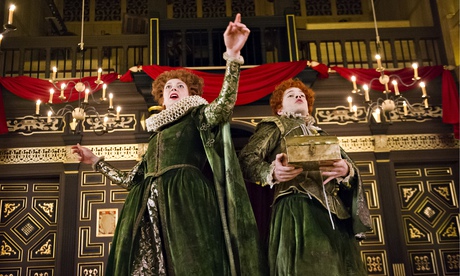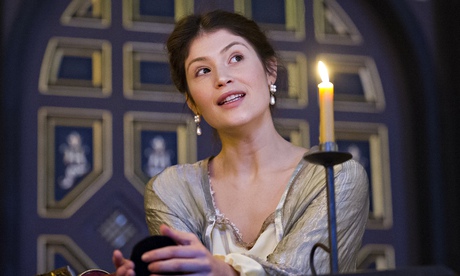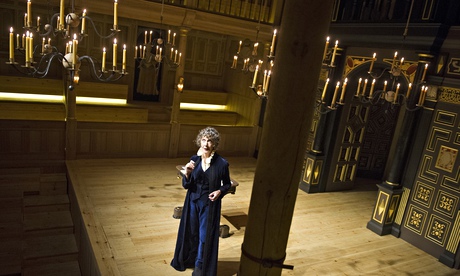Can't hold a candle to it: lighting the Sam Wanamaker Playhouse
From Liberace candelabras to fiery breeches, the theatre's Cumbrian-made candles shed a unique light on its shows

Nobody can hog the
limelight if there isn't any … Hannah McPake and Giles Cooper in The
Knight of the Burning Pestle. Photograph: Tristram Kenton
The candles at the Sam Wanamaker Playhouse couldn't be more
simple and elegant. Most of them are long, slender and slightly tapered,
like the fingers of fashionable gloves in Jacobean portraits. Their
wicks have been dipped and dipped again in molten Yorkshire beeswax at
Ted Thompson's Moorlands chandlery in Alston,
Cumbria, but if British bees don't increase their productivity soon,
he'll be supplementing domestic output with wax from small beekeepers in
Ethiopia.
The Wanamaker keeps around 2,000 candles in store, but that's hardly a fortnight's supply. For each comedy or tragedy, opera or recital, more than 100 are lit in the chandeliers or on the bronze sconces strapped to pillars. They're the lighting, the setting, the special effects; they can edit a production into cinematic noir, or party up an evening into conviviality. Very slowly, their honeyed smell and invisible smoke pervades the unvarnished oak and pine of the wooden casket that is the Wanamaker. Everything about the Wanamaker is experimental, and the candles are downright edgy.
I confess: I'm a candle fan. Nobody quite expected there would be real candles as the Wanamaker was being built – a US mock-up of Shakespeare's indoor playhouse has electric ones. But Martin White, professor of theatre at the University of Bristol and a spellbinder on the history of lighting (you should hear him talk about the smutty fug of mutton tallow dips), proselytised live flame from the start, in a fiery cabal with the Globe's artistic director Dominic Dromgoole. Together, they summoned the architects, the London fire brigade and the Globe's insurance company and auditioned candles. And they got the part.
The safety advisers saw how it would work: there's a megafan above the ceiling that can suck anything out, a smoke detection system that knows the difference between candle smoke and a problem, and the ventilation system makes draughts flow up, not across, so the flames barely even flicker. (Here's the science: a candle is a stick of solid hydrocarbon. Heat from its flame melts a pool of liquid fuel that slithers up the wick by capillary action and vaporises. Keep it upright, and it won't melt gutters in the pool's rim, through which hot wax can spill, and the wick will keep working to the last stub of wax. Tall candles emit a calm starriness; shorter, fatter candles glow on faces.)
So there they all were at the Wanamaker late last year with the first programme of productions finalised, and everybody was enthralled to the archaic novelty of candlelight – as are audiences as soon as they enter the theatre. People come in as the stage managers methodically light the chandeliers dropped on ropes, the luminescence equal to only a few bare bulbs. The audience's eyes adjust to the modest illumination by the time the branches soar upwards to about eight feet above the stage, their optimum height of operation. (Haul them above that, as Ben Jonson once specified, and a general darkness comes upon the stage – flame sheds light more from the side than from above.) The rising brilliance gets a gasp. But does it have possibilities beyond this?

The Wanamaker keeps around 2,000 candles in store, but that's hardly a fortnight's supply. For each comedy or tragedy, opera or recital, more than 100 are lit in the chandeliers or on the bronze sconces strapped to pillars. They're the lighting, the setting, the special effects; they can edit a production into cinematic noir, or party up an evening into conviviality. Very slowly, their honeyed smell and invisible smoke pervades the unvarnished oak and pine of the wooden casket that is the Wanamaker. Everything about the Wanamaker is experimental, and the candles are downright edgy.
I confess: I'm a candle fan. Nobody quite expected there would be real candles as the Wanamaker was being built – a US mock-up of Shakespeare's indoor playhouse has electric ones. But Martin White, professor of theatre at the University of Bristol and a spellbinder on the history of lighting (you should hear him talk about the smutty fug of mutton tallow dips), proselytised live flame from the start, in a fiery cabal with the Globe's artistic director Dominic Dromgoole. Together, they summoned the architects, the London fire brigade and the Globe's insurance company and auditioned candles. And they got the part.
The safety advisers saw how it would work: there's a megafan above the ceiling that can suck anything out, a smoke detection system that knows the difference between candle smoke and a problem, and the ventilation system makes draughts flow up, not across, so the flames barely even flicker. (Here's the science: a candle is a stick of solid hydrocarbon. Heat from its flame melts a pool of liquid fuel that slithers up the wick by capillary action and vaporises. Keep it upright, and it won't melt gutters in the pool's rim, through which hot wax can spill, and the wick will keep working to the last stub of wax. Tall candles emit a calm starriness; shorter, fatter candles glow on faces.)
So there they all were at the Wanamaker late last year with the first programme of productions finalised, and everybody was enthralled to the archaic novelty of candlelight – as are audiences as soon as they enter the theatre. People come in as the stage managers methodically light the chandeliers dropped on ropes, the luminescence equal to only a few bare bulbs. The audience's eyes adjust to the modest illumination by the time the branches soar upwards to about eight feet above the stage, their optimum height of operation. (Haul them above that, as Ben Jonson once specified, and a general darkness comes upon the stage – flame sheds light more from the side than from above.) The rising brilliance gets a gasp. But does it have possibilities beyond this?

Gemma Arterton in The Duchess Of Malfi. Photograph: Tristram Kenton
Oh yes. Dromgoole, directing the inaugural production, John Webster's The Duchess of Malfi,
picked up White's close reading of early works for the new playhouses –
which were in their time dark boxes, almost like cinemas where light
also controls image, mood, framing and narration. Even where there were
windows, shutters were mostly kept down: indoor theatre was meant to be
intimate, appealing to the unconscious as movies do (and with a music
score, too). Some Jacobean scripts had lighting cues, demanding the best
bright-burning wax candles on stage to make the dark denser when they
were extinguished.
"If any of it becomes more important than the story, you're screwed," said Dromgoole. So the candles for The Duchess of Malfi were serviced gravely – snuffed, and their wicks trimmed at the interval to keep them soot-free, and their chandeliers ceremonially raised and lowered. In northern Europe we have 1,500 years of church candle culture, and we still read their rituals as reverence.
And then, lights out! Malfi is the play in which the gothic enters the English imagination, and gothic can't enchant by day. So the chandeliers were put out, and characters carried their own lights, which reflected their true natures. The Duchess was sensuous yet vulnerable, with her face powdered pearly and lit by a single candle. The period's tall white collars acted like those parabolic reflectors in movie-making. Her matching cuffs magnified hand gestures, her rich clothes faded to dark masses. The ambivalent spy Bosola held his polished sconce high, half his profile strongly lit, the other indecipherable. The villains entered with Liberace candelabras in their fists; the mad Ferdinand might well have been, as he claimed, a werewolf, as flames glittering back from his eyes.
Light is the ultimate bit of stage business – Rada needs a candle module and the Wanamaker already has a workshop. Dromgoole had to teach his actors to share their light, move their candles slowly (or risk them blowing out) and relax with them. By chandelier shine, the show's in mid-shot; hand-held candles zoom it into extreme close-up. In fact, Dromgoole went as far as utter blackness for Malfi, where Webster only requested gloom. Jacobean revenge plays on the Globe stage pick up on their horrible comedy, but in the Wanamaker you scream: you just can't see things coming. And candlelight played straight cuts out the camp.
As Adele Thomas, the director of the Wanamaker's current production, The Knight of the Burning Pestle, was told glumly by everybody, nobody laughs in darkness. The first thing that struck her about the place: "not the oak – but that it was candlelit, the biggest elephant in the room." But the steady burn of the chandeliers dissolves the actor-audience fourth wall, just as its playwright Francis Beaumont wanted. In 1607, the audience "plants" sat on the stage and leaned in to interrupt the actors with their demands for an alternative play. In 2014, they bob between pit and stage, which share the same candle power. Nobody can hog the limelight if there isn't any.
Dromgoole was wary of the "National Trust carols at Christmas" nostalgia evoked by candles, but Thomas is going for a generous party atmosphere. The daftness of the show depends on a warmth made visible: brilliant light would scare the fun away. She got her comedy cues by "magpieing" from Droomgoole's Malfi workshop. Whatever he did with the candles that was solemn, she has perverted, to "take the piss out of this reverence".
Candles should be pinched or snuffed, not blown out (which disturbs the fuel pool), so Thomas decided "we must blow a few out". Malfi's candles were lit as if they were on altars. "So we have the worst possible lighting technique", she says, as well as the theatre's first candle joke, where the actors burn their breeches doing the job. There's also a Jacobean smoke machine: a candle and bellows. A funereal lowering of the chandeliers is ruined in Burning Pestle when the corpse sits up in the coffin; as a phoney ghost, he self-lights absurdly with a candlestick under his chin. The pastel costumes are sheeny, taking the advice of Francis Bacon and Inigo Jones that cheap gilt spangles on pink, and white silks show to perfection by candlelight, whereas fine embroidery looks like nothing.

"If any of it becomes more important than the story, you're screwed," said Dromgoole. So the candles for The Duchess of Malfi were serviced gravely – snuffed, and their wicks trimmed at the interval to keep them soot-free, and their chandeliers ceremonially raised and lowered. In northern Europe we have 1,500 years of church candle culture, and we still read their rituals as reverence.
And then, lights out! Malfi is the play in which the gothic enters the English imagination, and gothic can't enchant by day. So the chandeliers were put out, and characters carried their own lights, which reflected their true natures. The Duchess was sensuous yet vulnerable, with her face powdered pearly and lit by a single candle. The period's tall white collars acted like those parabolic reflectors in movie-making. Her matching cuffs magnified hand gestures, her rich clothes faded to dark masses. The ambivalent spy Bosola held his polished sconce high, half his profile strongly lit, the other indecipherable. The villains entered with Liberace candelabras in their fists; the mad Ferdinand might well have been, as he claimed, a werewolf, as flames glittering back from his eyes.
Light is the ultimate bit of stage business – Rada needs a candle module and the Wanamaker already has a workshop. Dromgoole had to teach his actors to share their light, move their candles slowly (or risk them blowing out) and relax with them. By chandelier shine, the show's in mid-shot; hand-held candles zoom it into extreme close-up. In fact, Dromgoole went as far as utter blackness for Malfi, where Webster only requested gloom. Jacobean revenge plays on the Globe stage pick up on their horrible comedy, but in the Wanamaker you scream: you just can't see things coming. And candlelight played straight cuts out the camp.
As Adele Thomas, the director of the Wanamaker's current production, The Knight of the Burning Pestle, was told glumly by everybody, nobody laughs in darkness. The first thing that struck her about the place: "not the oak – but that it was candlelit, the biggest elephant in the room." But the steady burn of the chandeliers dissolves the actor-audience fourth wall, just as its playwright Francis Beaumont wanted. In 1607, the audience "plants" sat on the stage and leaned in to interrupt the actors with their demands for an alternative play. In 2014, they bob between pit and stage, which share the same candle power. Nobody can hog the limelight if there isn't any.
Dromgoole was wary of the "National Trust carols at Christmas" nostalgia evoked by candles, but Thomas is going for a generous party atmosphere. The daftness of the show depends on a warmth made visible: brilliant light would scare the fun away. She got her comedy cues by "magpieing" from Droomgoole's Malfi workshop. Whatever he did with the candles that was solemn, she has perverted, to "take the piss out of this reverence".
Candles should be pinched or snuffed, not blown out (which disturbs the fuel pool), so Thomas decided "we must blow a few out". Malfi's candles were lit as if they were on altars. "So we have the worst possible lighting technique", she says, as well as the theatre's first candle joke, where the actors burn their breeches doing the job. There's also a Jacobean smoke machine: a candle and bellows. A funereal lowering of the chandeliers is ruined in Burning Pestle when the corpse sits up in the coffin; as a phoney ghost, he self-lights absurdly with a candlestick under his chin. The pastel costumes are sheeny, taking the advice of Francis Bacon and Inigo Jones that cheap gilt spangles on pink, and white silks show to perfection by candlelight, whereas fine embroidery looks like nothing.

Eileen Atkins as Ellen Terry. Photograph: Tristram Kenton
These revelations transfer over to the Wanamaker's solo recitals and
masterclass gigs. It's not that candlelight flattered Eileen Atkins in her one-woman show as Ellen Terry;
more that, as Dromgoole said, actors in candlelight become their own,
very flexible, lighting designers. Atkins turned slightly towards the
darkness to speak Lear, then, as Cordelia, looked right into the light,
and mobile flames made her eyes young and bright. The lighting changed
as fast as her voice and identity.
The Wanamaker is an experiment in progress – where it goes, nobody knows. There's no Shakespeare scheduled for 2014, although his last plays were written for the original Blackfriars playhouse: Cymbeline, its dodgy plot points plausible with the music up and the light down; The Winter's Tale, with its statue that isn't, animated by living flame or breath; and The Tempest, a total dream state. Just fantasise the lighting plan: chandeliers jerked up for storm lightning, the masque processing up on to stage with torches, Prospero's magic set out on the floor in arcanas of candles, and Ariel's single taper sparking all over the house. Those Brit and Ethiopian bees need to step up production right now.
The Wanamaker is an experiment in progress – where it goes, nobody knows. There's no Shakespeare scheduled for 2014, although his last plays were written for the original Blackfriars playhouse: Cymbeline, its dodgy plot points plausible with the music up and the light down; The Winter's Tale, with its statue that isn't, animated by living flame or breath; and The Tempest, a total dream state. Just fantasise the lighting plan: chandeliers jerked up for storm lightning, the masque processing up on to stage with torches, Prospero's magic set out on the floor in arcanas of candles, and Ariel's single taper sparking all over the house. Those Brit and Ethiopian bees need to step up production right now.

No comments:
Post a Comment